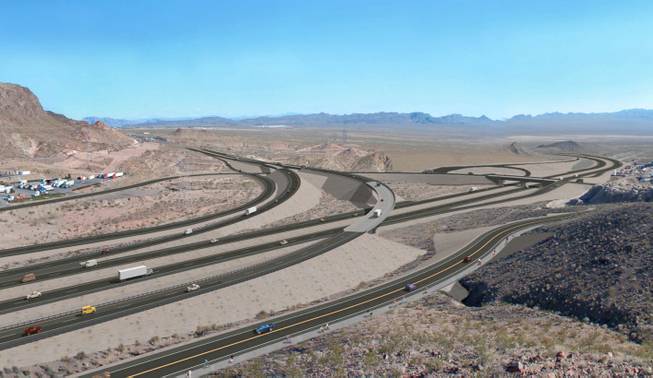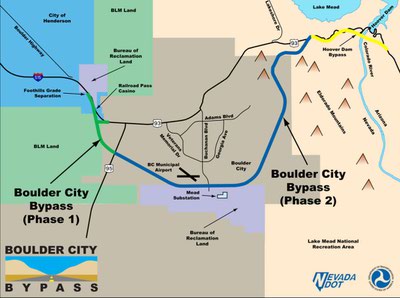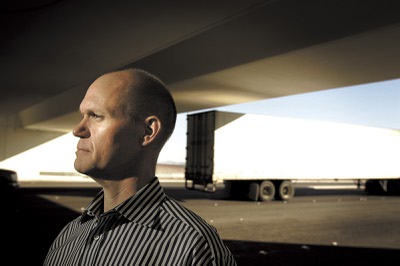
Nevada Department of Transportation
This artist’s rendering shows what the redesigned interchange of Boulder City Bypass and U.S. 93 would look like at Railroad Pass. Railroad Pass Casino is at left. If U.S. 93 is designated an interstate between Las Vegas and Phoenix, the bypass route would become part of the interstate, officials say.
Tuesday, July 13, 2010 | 5:08 p.m.
Sun Archives
- Engineering marvel taking shape near Hoover Dam (2-8-2010)
- Boulder City Council endorses Vegas-to-Phoenix interstate (8-12-2009)
- Freeway to Phoenix gains traction with bridge work (7-11-2009)
- Meeting planned to discuss changes to Boulder City Bypass (7-6-2009)
- Contractor selected for $270 million I-15 project (7-1-2009)
- A boost for DesertXpress (7-3-2009)
- Clark County roads wait for stimulus while rurals get work (6-10-2009)
- Declining gas tax revenue means fewer road projects (6-9-2009)
Sun Coverage
Once the Nevada Department of Transportation completes its work on the widening of Interstate 15 from Blue Diamond Road south, Southern Nevada’s most important tourism conduit will be done in Nevada and leaders can turn their attention to other pressing transportation needs, the Las Vegas Convention and Visitors Authority was told today.
Tom Skancke, president of The Skancke Co. Ltd. and a transportation consultant to the LVCVA, said with I-15 nearly completed, local leaders can turn their attention to the development of the proposed Interstate 11, a four-lane highway in the existing U.S. 93 corridor that would connect Las Vegas with Phoenix, one of Southern Nevada’s top tourism markets.
Las Vegas and Phoenix are the two largest cities in the country not linked by an interstate highway, Skancke said.
Projects partially paid for by the LVCVA have widened I-15 between the Spaghetti Bowl and Craig Road and created express lanes to separate through traffic from tourist traffic between Russell Road and Sahara Avenue. Another widening and expansion project south of Russell Road currently is under way.
The proposed I-11 would utilize the Mike O’Callaghan-Pat Tillman Memorial Bridge being built over the Colorado River and eventually could be extended north to Reno and Seattle, Skancke told LVCVA board members in his annual review of transportation projects affecting Southern Nevada’s tourism economy.
Representatives of Arizona’s Department of Transportation already have requested $2 million to $5 million to begin studies on the route, the first phase of which would link Las Vegas with Phoenix. Skancke said there’s already considerable progress on a portion of the highway between Interstate 10 and Wickenburg, Ariz., where a group of landowners has begun negotiating the transfer of 40,000 acres in the White Tank Mountains for right-of-way.
While Phoenix is an important tourism market for Las Vegas, the I-11 proposal is an important piece of transportation for commerce from Mexico, Skancke said. China is negotiating with Mexico for the development of a deep-water port at Punta Colonet in Baja California and the proposed I-11 is viewed as an important link to transport goods arriving at that port to the western United States.
The proposed I-11 isn’t the only highway outside of Nevada on Skancke’s radar. The San Bernardino Association of Governments is working to widen Interstate 215 in California between DeVore and Interstate 10. A $360 million design-build project that will widen the highway, add interchanges and high-occupancy-vehicle traffic lanes is expected to begin in July 2011, he said.
The last time a major freeway widening occurred in Southern California Skancke helped coordinate the freeway closure schedule to minimize the economic damage to Southern Nevada resorts. A similar plan is envisioned next year when work begins on the I-215 project.
Skancke also is monitoring progress on the so-called High Desert Corridor project that would link Victorville with Palmdale, Calif. The proposed 50-mile highway would provide a new traffic access from several Southern California communities to Southern Nevada.
The corridor also would include high-speed rail right-of-way, access the developers of the DesertXpress train line are counting on to eventually offer train service beyond Victorville. DesertXpress is expected to begin construction next year on a high-speed rail line between Las Vegas and Victorville, and California’s high-speed train system will pass through Palmdale. The link between Victorville and Palmdale would be key to integrating the systems.
Skancke also briefed the LVCVA board on other train proposals. Skancke was instrumental in forming the Western High Speed Rail Alliance, a coalition of regional transportation planners including the Regional Transportation Commission of Southern Nevada that is developing a high-speed rail strategy for the West.
The alliance is seeking funding from the federal government to begin the development of high-speed-rail corridors between Las Vegas, Los Angeles and Phoenix with long-term plans to extend to Salt Lake City, Denver, Reno and San Francisco.
Skancke also urged the board to consider how Southern Nevada’s tourism industry should respond if the state of California orders cars in that state to be electrified in the future. He said Las Vegas is not prepared to accommodate plug-in sites for electric cars traveling from California to Southern Nevada.
In other business, the LVCVA welcomed Las Vegas Chamber of Commerce President Matt Crosson to the board. He and Wynn Resorts President Andrew Pascal were appointed as representatives of the Las Vegas Chamber. Crosson replaces former Chamber President Kara Kelley, whom Crosson succeeded at the chamber. Pascal was reappointed to a new two-year term. Also reappointed for two years was Boyd Gaming CEO Keith Smith, who was nominated to the LVCVA board by the Nevada Resort Association.
The board also unanimously approved spending $225,500 to promote Las Vegas to corporate meeting planners at the Incentive Travel & Meeting Executives show in Chicago in October, $125,000 to sponsor Supercross Unleashed as a special event Oct. 16 at Sam Boyd Stadium and $10,000 to fund the 2011 Primm Winterbreak, another special event.
The board’s audit committee also received a report from Jon Reese, the LVCVA’s director of internal audit, on audits of the LVCVA’s Aramark food service concessionaire, the organization’s procurement card program, the personnel department, investments and the organization’s advertising agreement with R&R Partners.
Reese said his team found a few minor issues in the audits, including no reportable issues on the R&R agreement. The LVCVA has been criticized publicly by the Nevada Policy Research Institute about its dealings with R&R, but the audit found no compliance problems with internal controls or the payment process based on a study of documents produced between March 1, 2009, and April 2, 2010.



Join the Discussion:
Check this out for a full explanation of our conversion to the LiveFyre commenting system and instructions on how to sign up for an account.
Full comments policy